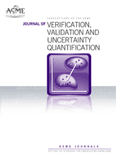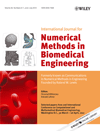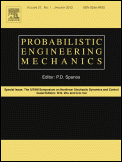
Journal of Verification, Validation and Uncertainty Quantification
Scope & Guideline
Advancing Reliability in Engineering and Computation
Introduction
Aims and Scopes
- Verification and Validation (V&V) Methodologies:
The journal emphasizes the development and application of rigorous V&V methodologies to ensure that computational models accurately represent their intended physical systems. - Uncertainty Quantification (UQ) Techniques:
Research in this area focuses on quantifying and reducing uncertainties in model predictions, employing statistical and probabilistic methods to enhance model reliability. - Applications Across Disciplines:
The journal covers a broad spectrum of applications, including but not limited to fluid dynamics, structural engineering, biomedical engineering, and manufacturing processes, showcasing the interdisciplinary nature of V&V and UQ. - Advanced Computational Techniques:
Papers often explore advanced computational techniques such as machine learning, Bayesian methods, and high-fidelity simulations that contribute to improved V&V and UQ practices. - Experimental Validation:
The journal acknowledges the importance of experimental validation in supporting computational findings, presenting studies that bridge the gap between theoretical models and empirical data.
Trending and Emerging
- Machine Learning Applications:
An increasing number of papers are focusing on the integration of machine learning techniques into V&V and UQ processes, showcasing their potential to enhance model predictions and streamline validation efforts. - Multifidelity Modeling Approaches:
There is a growing trend towards multifidelity modeling strategies that combine various levels of detail and computational resources to achieve efficient and accurate uncertainty quantification. - Bayesian Methods for Uncertainty Quantification:
Bayesian approaches are becoming increasingly prominent in UQ, allowing researchers to incorporate prior knowledge and update model predictions based on new data. - Resilience and Risk Assessment in High Consequence Systems:
Research focusing on resilience modeling and risk assessment for high consequence systems under uncertainty is on the rise, reflecting a broader consideration of safety and reliability in engineering. - Integration of Experimental and Computational Methods:
Emerging studies are increasingly emphasizing the synergy between experimental validation and computational modeling, aiming to create more robust validation frameworks that leverage both approaches.
Declining or Waning
- Traditional Statistical Methods:
There has been a noticeable decrease in papers employing traditional statistical methods for uncertainty quantification, as more sophisticated techniques such as machine learning and Bayesian approaches gain traction. - Basic Verification Techniques:
Basic verification methods that do not incorporate advanced computational tools or comprehensive frameworks are becoming less common, indicating a trend towards more complex and integrated verification strategies. - Focus on Single-Domain Studies:
Research that focuses solely on single-domain applications (e.g., just fluid dynamics or structural mechanics) has diminished as interdisciplinary approaches that combine multiple domains and perspectives become more valued. - Static Models without Adaptive Components:
There is a waning interest in static models that do not adapt to new data or uncertainties, reflecting a shift towards dynamic and adaptive modeling techniques that can evolve with incoming data.
Similar Journals

Journal of Computational and Nonlinear Dynamics
Advancing the Frontiers of Computational Dynamics.Welcome to the Journal of Computational and Nonlinear Dynamics, a leading publication in the fields of applied mathematics, control and systems engineering, and mechanical engineering, published by the esteemed American Society of Mechanical Engineers (ASME). With an ISSN of 1555-1423 and an E-ISSN of 1555-1415, this journal has been a vital resource since its inception in 2006, promoting high-quality research and innovative methodologies aimed at solving complex engineering problems. With a commendable impact in academic circles, it ranks in the Q3 quartile for Applied Mathematics and Control and Systems Engineering, and Q2 for Mechanical Engineering as of 2023. The journal facilitates the dissemination of research findings, theoretical advancements, and practical applications, making it an essential platform for researchers, professionals, and students looking to advance their knowledge and engage with cutting-edge dynamics research. While currently not available as an open-access publication, subscribers benefit from a wealth of scholarly articles that contribute to the academic community's understanding of computational and nonlinear dynamics in various engineering disciplines.

International Journal for Numerical Methods in Biomedical Engineering
Exploring the Intersection of Engineering and MedicineInternational Journal for Numerical Methods in Biomedical Engineering is a premier peer-reviewed journal dedicated to promoting advancements in numerical methods and their applications in the biomedical engineering field. Published by WILEY and based in the United States, this journal serves as a vital platform for disseminating innovative research from 2010 to 2024, with a focus on bridging the gap between computational techniques and real-world biomedical challenges. With an impressive impact factor and categorized in the Q2 quartile across several fields including Applied Mathematics and Biomedical Engineering, it ranks among the top journals in its domain. The journal provides free access to its content, making it an invaluable resource for researchers, professionals, and students eager to explore groundbreaking methodologies. By fostering interdisciplinary collaboration and showcasing high-quality research, International Journal for Numerical Methods in Biomedical Engineering plays a crucial role in advancing our understanding of complex biomedical systems through numerical analysis.

Ukrainian Metrological Journal
Elevating Standards in Measurement Science and TechnologyThe Ukrainian Metrological Journal is a vital publication within the field of metrology, managed by the esteemed NATL SCIENTIFIC CENTER INST METROLOGY in Ukraine. With a focus on disseminating impactful research, the journal aims to foster advancements in measurement science and technology. Notably, this journal operates under an Open Access model, ensuring that the latest findings are readily available to a global audience, thus facilitating collaboration and innovation. Its ISSN 2306-7039 and E-ISSN 2522-1345 indicate its commitment to maintaining rigorous publishing standards. The Ukrainian Metrological Journal serves as a platform for researchers, professionals, and students to share insights, methodologies, and applications relevant to the evolving challenges in metrology, thereby elevating the discourse and practice within this crucial scientific field.

PROBABILISTIC ENGINEERING MECHANICS
Advancing the Frontiers of Engineering with Probability.PROBABILISTIC ENGINEERING MECHANICS is a premier academic journal published by Elsevier, focusing on the rapidly evolving field of engineering mechanics with a probabilistic approach. Established in 1986, the journal has become an essential resource for researchers, professionals, and students, providing insights into various disciplines such as aerospace engineering, civil and structural engineering, and nuclear energy, among others. With a consistent Q2 ranking across multiple engineering categories, it reflects high-quality research and significant contributions to the field. Although it does not operate under an open access model, it offers invaluable access to advanced methodologies and innovative applications in engineering. The journal aims to promote the development and dissemination of probabilistic approaches to tackle complex engineering problems, thus bridging the gap between theoretical research and practical application. Located in the heart of the UK, PROBABILISTIC ENGINEERING MECHANICS continues to shape the future of engineering through rigorous peer-reviewed articles that influence both academia and industry.

NONLINEAR DYNAMICS
Exploring the Frontiers of Nonlinear PhenomenaNONLINEAR DYNAMICS is an esteemed academic journal published by SPRINGER, focusing on a diverse range of topics within the fields of Aerospace Engineering, Applied Mathematics, Control and Systems Engineering, Electrical and Electronic Engineering, Mechanical Engineering, and Ocean Engineering. Since its inception in 1990, this journal has become a premier platform for disseminating cutting-edge research and innovative methodologies from both theoretical and practical perspectives. With a high impact factor and ranked in the Q1 quartile across several engineering and mathematics categories, NONLINEAR DYNAMICS is recognized for its significant contribution to advancing knowledge and technology in nonlinear phenomena. Researchers and professionals are encouraged to engage with this journal to publish their findings and stay at the forefront of developments. Although it does not offer open access options, the journal ensures rigorous peer review, enhancing the credibility and visibility of published work.

STRUCTURAL EQUATION MODELING-A MULTIDISCIPLINARY JOURNAL
Elevating Academic Discourse with SEM ExcellenceSTRUCTURAL EQUATION MODELING-A MULTIDISCIPLINARY JOURNAL, published by ROUTLEDGE JOURNALS, TAYLOR & FRANCIS LTD, stands as a premier platform for the dissemination of innovative research and applications in structural equation modeling (SEM). With ISSN 1070-5511 and E-ISSN 1532-8007, this journal has maintained a robust impact in various academic realms since its inception in 1994. Renowned for its exceptional quality, it ranks in the Q1 category across four distinct disciplines, including Decision Sciences, Economics, Econometrics and Finance, Modeling and Simulation, and Sociology and Political Science. The journal's impressive Scopus rankings reflect its significant influence, particularly in Economics and Sociology, with percentile ranks placing it in the top tier of relevant fields. Researchers, professionals, and students alike will benefit from its comprehensive articles, which explore theoretical advancements and practical applications of SEM. In a landscape increasingly dependent on data-driven decision-making, the journal serves not only as a pivotal resource for current trends and methodologies but also as an essential guide for future explorations in multidimensional data analysis.

SIAM-ASA Journal on Uncertainty Quantification
Unraveling the complexities of uncertainty in modern science.The SIAM-ASA Journal on Uncertainty Quantification, published by SIAM PUBLICATIONS, is a premier journal dedicated to advancing the field of uncertainty quantification across various disciplines, including applied mathematics, statistics, and simulation modeling. With an impressive impact factor that places it in the Q1 quartile in multiple categories such as Applied Mathematics and Statistics and Probability, this journal represents the pinnacle of research quality and relevance. Established in 2013, it has garnered a significant readership and citation rate, reaffirming its critical role in addressing complex uncertainty challenges in modern science and engineering. Although not an open access journal, it provides a platform for rigorous peer-reviewed articles that offer insightful methodologies and applications vital to both research and industry practices. Researchers, professionals, and students will find in its pages a wealth of knowledge that drives the future of quantitative analysis, modeling, and problem-solving in uncertain environments.

Journal of Statistical Theory and Applications
Connecting researchers to elevate the discourse in statistics.Journal of Statistical Theory and Applications is a prominent open-access journal published by SPRINGERNATURE, dedicated to advancing the fields of statistics, applied mathematics, and computer science. Operating since 2013, this journal serves as a vital platform for researchers to disseminate their findings and contributes significantly to the global discourse in statistical theory and its practical applications. With an impressive Q3 quartile ranking in 2023 across multiple categories including Applied Mathematics and Statistics, the journal showcases quality research, and its Scopus rankings position it favorably within its fields, reflecting its growing influence and accessibility. The journal emphasizes the importance of making research freely available, adhering to open access principles, which facilitates knowledge sharing among academics, practitioners, and students worldwide. By fostering innovative statistical methodologies and applications, the Journal of Statistical Theory and Applications plays a crucial role in shaping contemporary statistical practice and education.

International Journal of Mechanics and Materials in Design
Elevating Design Methodologies through Cutting-Edge ResearchInternational Journal of Mechanics and Materials in Design is a leading publication in the field of mechanical engineering and materials science, published by Springer Heidelberg. With an impressive impact factor, it holds esteemed rankings as Q1 in both Mechanical Engineering and Mechanics of Materials, and Q2 in Materials Science for the year 2023, solidifying its reputation as a significant contributor to the advancement of design methodologies. The journal focuses on the intersection of mechanics and materials, encouraging innovative research that addresses contemporary challenges faced in engineering disciplines. Researchers and professionals alike can benefit from accessing cutting-edge studies contributing to various applications, making it an invaluable resource for staying informed in this dynamic field. While the journal operates under a subscription model, its comprehensive reviews and high-quality original research foster a deeper understanding of material behavior and design principles, thus supporting the academic growth and professional development of its readers.

INTERNATIONAL JOURNAL OF COMPUTATIONAL FLUID DYNAMICS
Connecting Researchers and Practitioners in CFD ExcellenceInternational Journal of Computational Fluid Dynamics, published by Taylor & Francis Ltd, is a prominent academic journal dedicated to advancing the field of computational fluid dynamics (CFD). Since its establishment in 1993, the journal has provided a platform for disseminating high-quality research, covering a wide spectrum of topics across various engineering disciplines, including Aerospace Engineering, Computational Mechanics, and Mechanical Engineering. With an impact factor placing it within Q2 categories across several relevant fields, the journal holds a significant position in the academic community, evidenced by its diverse Scopus rankings. Researchers and practitioners engage with state-of-the-art methodologies and innovative applications presented within its pages, contributing to both theoretical development and practical solutions in fluid dynamics. Though it currently operates under a subscription model, the journal remains a vital resource for those seeking to deepen their understanding of computational techniques and their application in industries spanning engineering and physics. This makes it an essential read for professionals, researchers, and students alike, striving for excellence in this dynamic and evolving area of study.